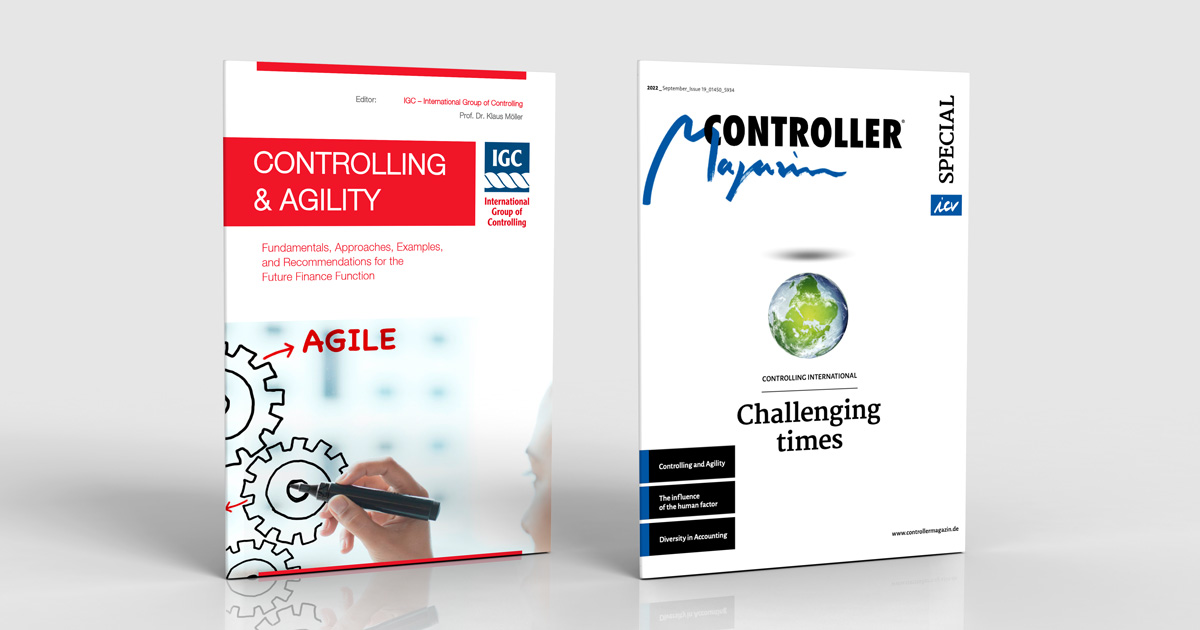Controlling & Agility

An article from the Controller Magazin Special “Challenging times”
September 2022
By Klaus Möller / Jasmin Schmid
The International Group of Controlling (IGC) has published the reference book Controlling & Agility – Fundamentals, Approaches, Examples and Recommendations for the Future Finance Function. The authors describe in detail the most important terms, instruments, functionalities as well as advantages and disadvantages.
Agility has become a multifaceted phenomenon somewhere between buzzword, trend, and fundamental change. Some consider it to be a mere empty phrase without substance, preferably placed as a prefix in front of all terms (in this case: agile controlling), while others see it as the next big thing with the potential to change the corporate world. This book takes a pleasing middle course and shows in concrete examples what can be changed with agility in controlling. It offers an incredibly comprehensive and well-founded overview of numerous (46) agile approaches. It introduces core approaches such as Scrum and Kanban, more IT-oriented approaches such as Extreme Programming, and also leadership-oriented approaches such as Everest goals as well as holistic practices like OKRs, OGSM, or Holacracy. The publisher is the International Group of Controlling (IGC), which ICV is also a member of. The team of authors around Prof. Dr. Klaus Möller (IGC board member) positions the book not as a future standard, but as an overview on the way to the continuous development of controlling. Thus the title with the “&” is cleverly chosen. The fact that the book is available in open-access via the IGC website is extremely commendable and should contribute to a fast and large distribution, which is absolutely to be wished for the book.
In the last 30 years, various forms of agility have developed, including operational, strategic, process, cultural, and structural agility, which are nowadays often used as synonyms. The diverse application of the terms can be attributed to their multidisciplinary emergence, particularly in software development, supply chain management, and manufacturing. The focus of the book is on organizational agility and the comprehensive description of the phenomenon, especially the concrete agile approaches and their use in controlling. The book is divided into seven chapters, starting by showing the relevance of agility in the field of controlling. The second chapter briefly lays the conceptual and theoretical foundations, such as the conceptual sharpening of organizational agility and related management concepts, the values and principles of the Agile Manifesto, and dynamic capabilities as a basic prerequisite for achieving agility. The main component of the book is Chapter 3 with almost 100 pages presenting 46 agile approaches with definition, application, process, and pros and cons. A selection of approaches is highlighted with eleven company examples in the fourth chapter by guest authors from the field. The examples range from minor agile adaptations to fundamental changes and from small companies in Croatia to global corporations such as Bosch. The particular challenge of the agile organization also becomes clear: There is no universal agile approach, rather it depends on various factors. In Chapter 5, these challenges are addressed through three recommendations for action: Finally, in chapter 6, the book gives an outlook on the future change of the controlling function as well as the controller. Very pleasing is the comprehensive bibliography, which contains further literature directly sorted by the respective agile approaches. This also shows the strength of the electronic open-access book: The reader can directly access in-depth sources via the embedded links.
In summary, the book is aimed at managers and controllers who want to take a well-founded look at the topic of agility and its design and implementation options in controlling. It becomes clear that agility is not only a supporting factor for taking on the role of a business partner. It can also be an essential element to support the development of digital and integrated performance management systems. Thus, the book nicely demonstrates that agility is an opportunity for controllers to be a reliable partner in a changing world and changing organizations to drive their progress.
Read more and download the Controller Magazin Special here.



